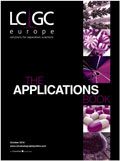A Novel Sample Preparation Device for Improved Phospholipid Removal in Bioanalytical Assays
Waters Application Note
Jessalynn P. Wheaton, Erin E. Chambers and Diane M. Diehl, Waters Corporation, Milford, Massachusetts, USA.
Introduction
Matrix effects are residual components of a biological matrix that alter mass spectrometry response, decrease method robustness, add to method variability and lead to poor limits of detection/quantification. A major source of matrix effects in plasma-based bioanalytical assays is residual phospholipids. If not removed from the sample, phospholipids can build up on analytical columns, elute at unpredictable times in subsequent injections and negatively impact assay robustness in a number of different ways. Over the past few years, it has become commonplace to monitor phospholipids during method development and to implement strategies to remove them from plasma samples. Ostro Sample Preparation Products are designed to provide a novel solution for the rapid and simple clean-up of phospholipids in biological samples prior to LC–MS–MS analysis.

Figure 1: (a) Average analyte recovery of a diverse analyte mix using protein precipitation, Ostro 96-well plate, 2 competitive phospholipid removal 96-well plates and (b) LLE and SSLE
Experimental
System: Waters ACQUITY UPLC System with a Waters Xevo TQ MS triple quadrupole mass spectrometer operated in positive ion MRM mode
Column: ACQUITY UPLC BEH C18 2.1 × 50 mm, 1.7 µm
Flow rate: 0.6 mL/min
Injection: 8 µL

Figure 2: (a) Comparison of phospholipids remaining in extracted samples using Ostro, two competitive phospholipid removal products and protein precipitation and (b) compared to LLE and SSLE.
Results and Discussion
Samples were processed on the Ostro 96-well plate using a generic, simple protocol provided by the manufacturer and a set of diverse analytes. The Ostro plate provided overall significantly better recovery for the analytes tested [Figure 1(a) and (b)] than PPT, LLE, SSLE and competitive PL removal plates. The Ostro 96-well plate also removed significantly more phospholipids than the current phospholipid removal products on the market, PPT, LLE and SSLE [Figure 2(a) and (b)]. In addition, not only was the level of PL removal better, but PLs were removed in a significantly more reproducible manner when the Ostro sample prep product was used versus competitive PL removal devices (Figure 3). The average RSD for lipid removal across six sources of human plasma using Ostro was <1%, while competitive plates exhibited RSD's between 24 and 41% for lipid removal.

Figure 3: % phospholipid removal in 6 lots of human plasma.
© 2010 Waters, ACQUITY UPLC, UPLC are registered trademarks of Waters Corporation. Xevo, Ostro and The Science of What's Possible are trademarks of Waters Corporation.

Waters Corporation
34 Maple Street, Milford, Massavhusetts 01757, USA
tel. +1 508 478 2000 fax +1 508 478 1990
Website: www.waters.com

Silvia Radenkovic on Building Connections in the Scientific Community
April 11th 2025In the second part of our conversation with Silvia Radenkovic, she shares insights into her involvement in scientific organizations and offers advice for young scientists looking to engage more in scientific organizations.
Regulatory Deadlines and Supply Chain Challenges Take Center Stage in Nitrosamine Discussion
April 10th 2025During an LCGC International peer exchange, Aloka Srinivasan, Mayank Bhanti, and Amber Burch discussed the regulatory deadlines and supply chain challenges that come with nitrosamine analysis.
Removing Double-Stranded RNA Impurities Using Chromatography
April 8th 2025Researchers from Agency for Science, Technology and Research in Singapore recently published a review article exploring how chromatography can be used to remove double-stranded RNA impurities during mRNA therapeutics production.



















